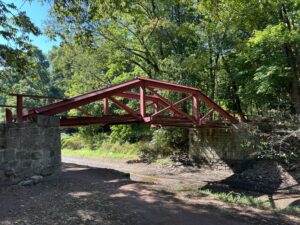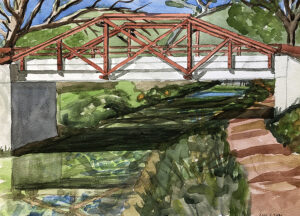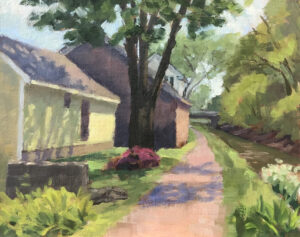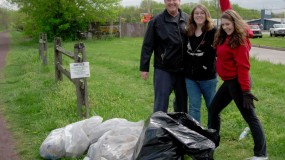Canal News – Fall 2022
PENNSYLVANIA 2022 TRAIL OF THE YEAR
Delaware Canal State Park Towpath
On September 9, 2022, the Friends of the Delaware Canal received the Trail of the Year Award from the Department of Conservation and Natural Resources. The timing for this recognition is perfect. It coincides with the Friends’ 40th anniversary.

PA State Senator Steve Santarsiero; Michael Ginder, FODC Executive Director; Jack Torres, FODC Board Secretary;
and Brett Webber, FODC Board President.
“We are excited to accept this award for the Delaware Canal Towpath,” said Michael Ginder, Executive Director of the Friends. “We received a great deal of support and input from community members advocating for this nomination. Their enthusiasm for the Delaware Canal towpath earned our beloved greenway this mark of distinction.”
Pennsylvania has long been a leader in trail development and natural resource conservation. In comparison to other U.S. states, the commonwealth ranks 33rd in terms of land mass but 8th in
terms of state parks. We have over 11,000 miles of trails throughout Pennsylvania to enjoy and explore.
This award comes to us from the Pennsylvania Trails Advisory Committee. Their goal is to build enthusiasm and support for both large and small trails and raise public awareness about the value of Pennsylvania’s trail network. During the recent ceremony, representatives from the State, Park Service, and FODC met at the Locktender’s House in New Hope to officially recognize the Delaware Canal and Towpath.
Even though the Friends are the “official” recipient of the award, the Delaware Canal State Park managers and employees deserve recognition for all they do throughout the year. Preserving and protecting the Canal and towpath is truly a team effort.
*************************************************************************************************************************************
A Tale of Two Canals

Many towpath visitors take advantage of the Loop Trails that connect Pennsylvania with New Jersey. Both states have similar canals and histories but serve very different purposes today.
The Delaware Canal in Pennsylvania and the Delaware and Raritan Canal in New Jersey began as transportation waterways. These canals were designed mainly to transport coal to cities in both states. The Delaware and Raritan Canal crossed New Jersey from Bordentown to New Brunswick, connecting the Delaware and Raritan Rivers. The canal eliminated the need to use the Atlantic Ocean route to get from Philadelphia to New York, thus reducing travel time from two weeks to two days.
The canal boats on the Delaware Canal made their way from Easton to Bristol via New Hope. Here, boats headed to New York crossed the Delaware River via a cable ferry across the river to Lambertville. The boats continued their journey south from Lambertville on the D&R Canal. There are remnants of the cabling system in New Hope today, behind the River House at Odette’s.
This section of the D&R Canal along the Delaware River is called the feeder canal because it feeds Delaware River water into the main canal at Trenton. The feeder starts at Bulls Island and runs through Stockton, Lambertville, Washington Crossing, and Trenton.
 However, the Delaware Canal and the D&R Canal would be forever changed by the expansion of the railroad throughout the two states. In 1871, the Pennsylvania Railroad leased the D&R Canal for 999 years and, after many years of financial losses, ceased operating the canal in 1933. The remainder of the canal was turned over to the state of New Jersey in 1937.
However, the Delaware Canal and the D&R Canal would be forever changed by the expansion of the railroad throughout the two states. In 1871, the Pennsylvania Railroad leased the D&R Canal for 999 years and, after many years of financial losses, ceased operating the canal in 1933. The remainder of the canal was turned over to the state of New Jersey in 1937.
Once the railroad began connecting major cities along the East Coast, the canal could not compete. Consider that the trains ran all night and all year, but the canals did not operate at night or during the winter. Thus, the canals went into deficit and eventually ended operation as transportation systems. Both canals became the property of their respective states.
In Pennsylvania, the canal and towpath were repurposed as the Delaware Canal State Park, which was created in 1940. In 1937, the Delaware and Raritan Canal was turned over to the state of New Jersey. And while both canals became popular recreation spots, the feeder canal of the Delaware and Raritan Canal continued its original purpose, to “feed” or send water to the main canal. This canal is operated by the New Jersey Water Supply Authority, providing drinking water to over 1,000,000 residents of Central New Jersey. As a consequence, this canal is always fully watered.
************************************************************************************************************************************
Sommer’s Bridge Restoration—A Family Legacy Lives On
The Canal has many tales to tell, and so do the bridges and buildings along the way. The Sommer’s Bridge is no exception. In its day, farmers, quarrymen, and the townspeople used this bridge. Today, it is used solely as a pedestrian walkway. And due to its location, it gets a great deal of foot traffic.
 Sommer’s Bridge is one of the six remaining authentic camelback bridges along the towpath. These structures can be found as far south as Yardley, and as far north as Raubsville. They were built with several functions in mind. First, the design, also known as a Queenspost style bridge, had an arched design that better accommodated the crew on the canal boats. They also connected two land parcels separated by the Canal’s installation.
Sommer’s Bridge is one of the six remaining authentic camelback bridges along the towpath. These structures can be found as far south as Yardley, and as far north as Raubsville. They were built with several functions in mind. First, the design, also known as a Queenspost style bridge, had an arched design that better accommodated the crew on the canal boats. They also connected two land parcels separated by the Canal’s installation.
When they were first constructed, the camelback bridges were wooden structures with iron fasteners that added to the bridge’s stability. Workers placed these spans on stone abutments with wing walls that held the bridge about eight feet over the Canal.
The stone also has historical significance. Local materials were used to create these structures, so each one is unique depending on the camelback bridge’s location. High-quality brownstone from nearby quarries was the stone of choice in Yardley and Taylorville. Ashlar, from Lumberville, was transported north to Durham and used to build many stone abutments in that region.
The Friends have, with the help of donors and supporting organizations, restored all but one of the remaining bridges. Several camelbacks, like Sommer’s Bridge, have been restored or repaired more than once. Wooden structures are prone to decay and rot, even when maintained. So, we were not surprised that the Sommer’s Bridge experienced some structural issues this past winter that necessitated its closing. In May restoration began. It took a bit longer than originally planned as additional repairs were uncovered during the first phase of the work.
Most of the initial funding was donated by the Sommer Family. The family has a long history with the Canal and the towpath. Dr. George Sommer and his wife Anna purchased the property adjacent to the Bridge over seventy years ago. The Sommer Family have been active members of the Friends and supporters of preserving and restoring the canal structures and towpath. As is the custom with all camelback bridges, this bridge was named for the family that owned the property.
We recently received this reminiscence from the Sommer Family that we wanted to share:
“From 1951 through 2022, four generations of the Sommer family have enjoyed their property stretching from the Canal to the river. The Bridge has a very special meaning. During the 20th century flood in August of 1955, the Delaware, fed by torrential rains upriver, rose quickly on a bright summer’s day. Some family members at home were about to be trapped by the rising waters. The two youngest Sommer sisters, Anna aged six and Julie age 4, were assisted by a neighbor navigating the water on a path leading toward the Bridge and high ground. Many other area residents had the Bridge to thank for their means to safety. The Sommer Family is delighted to help the Friends of the Delaware Canal in the excellent rehabilitation of the Bridge. We do this in memory of our late family members, including Juliet C. Sommer, who died in September of 2020.”
Over the past six months, we have received contributions from other generous donors. However, additional funding will be needed to finance the completed project fully. If you would like to contribute to this bridge restoration fund, please visit our website or email us at friends@fodc.org.
************************************************************************************************************************************
What’s Happening at the Locktender’s House
Stop by the Locktender’s House at 145 South Main Street in New Hope for a new exhibit and surprises.
 NEW EXHIBIT—Coming soon! Rediscovering the Towpath: The Legacy of William Francis Taylor. Learn about the fascinating life of William Taylor, artist, writer and early advocate for the Delaware Canal. Before the Friends of the Delaware Canal came into being, there was the Delaware Valley Protective Association, and William Francis Taylor was its first president.
NEW EXHIBIT—Coming soon! Rediscovering the Towpath: The Legacy of William Francis Taylor. Learn about the fascinating life of William Taylor, artist, writer and early advocate for the Delaware Canal. Before the Friends of the Delaware Canal came into being, there was the Delaware Valley Protective Association, and William Francis Taylor was its first president.
POP-UP HOLIDAY SHOP: Stop by our Pop-up Holiday Shop and find just the perfect gift that keeps on giving. Proceeds of all sales benefit the Friends. And the tastefully branded items are a great reminder of the Canal and the efforts of so many to preserve this historic landmark for generations to come. Choose from wearables and other handy items that show you care.
Please put the Locktender’s House on your holiday itinerary.We hope to see you soon!
************************************************************************************************************************************
PARK MANAGER’S REPORT
This summer season we focused on upkeep and maintenance. The maintenance staff and laborers were busy cleaning the canal bank and towpath. Our management team responded to input from the local community, removing trees and large debris as needed. As we move into the fall, we look forward to securing contracts to execute some significant repairs and finalize design plans for others.
Staffing: As with many companies and organizations, staffing has been an issue. We were able to fill two seasonal laborer positions recently. Our hope is they will return next year.
Project updates:
• In the northern section of the towpath and canal, temporary trail repairs in Easton have been completed. The Nockamixon Cliffs river wall and the Tohickon Aqueduct repairs are done.
• In the southern section, Sommer’s Bridge repairs are complete. The Morrisville Bridge Street Crossing is moving forward in cooperation with the Borough and PennDOT. We completed dredging at the New Hope inlet to increase the volume of water flowing south.
• Projects in the planning or bidding phase include repairs to the Lumberville Aqueduct and High Falls culvert, along with rebuilding Spahr’s Bridge in Upper Black Eddy.
Equipment: We expect our new mowers and the backhoe to arrive this fall.
Mowing: The flail mower is moving through Point Pleasant and, barring any issues, will be wrapping up its second pass of the season in the next few weeks. The boom mower is making its way South through Upper Black Eddy. The maintenance staff in the southern section of the canal has managed vegetation growth. In many places, the drought has suppressed the growth of plants along the towpath.
Water: There is currently a maintenance level of water moving as far south as possible before High Falls. Waste gates are closed to retain rainwater South of High falls. As we enter into storm season, that is subject to change to prevent exacerbating erosion at High Falls and Lumberville in cases of large rain volumes. Waste gates will be opened for storms even though everything will discharge at High Falls. Opening the gates is an effort to prevent extra water and erosion compounding our existing storm damage. We can close them post-storm to retain some water coming down off the hills and creeks.
The drought this past summer caused a drop in water levels in places that are generally fully watered. Plans are underway to help supplement the water supply in the south, while other northern projects focus on needed infrastructure repairs. We continue to work to keep the public safe and the towpath clear, improving the recreational experience for all.
Thank you all for your continued support.
See you on the towpath!
************************************************************************************************************************************
Artistic Impressions of the Canal–Past and present
Whether you are a painter or photographer, no matter the medium, the canal inspires artists, and it has done so for nearly two centuries. As long as the canal has flowed through this region, artists have interpreted the natural beauty of this scenic waterway.
The completion of the Delaware Canal in 1832 fueled growth along its path. Mills of all kinds began to flourish along with quarries, farms, and foundries. Activity peaked during the Civil War, however many people drawn here by industry came to cherish the beauty of the local area.
By the turn of the century, New Hope and other river towns began to grow a colony of artists. These new settlers included William Lathrop, and Edward Redfield, who were joined later by Daniel Garber, Fern Coppedge, and William Taylor. They all tended to be impressionistic in style, with later artists becoming bolder in their use of color and form. Here is a brief synopsis of some of the body of work left behind for all to enjoy today.
William Langston Lathrop (1859-1938) is considered the founder of the New Hope Art Colony. He came to the hamlet of Phillips Mill in 1899 and established an art school, often taking his students on his canal boat, Sunshine, for en plein air landscaping painting excursions. Lathrop mentored many aspiring painters and was credited with attracting many artists to the area, including Daniel Garber and Morgan Colt, both members of what became known as the New Hope Group.
Along with his love of teaching, Lathrop was an avid sailor. He hand-built a sailboat named The Widge in his backyard along the Canal. It launched in 1930, and Lathrop spent a considerable amount of time sailing up and down the east coast. At the age of 79, he was sailing off the coast of Long Island when a hurricane approached. Although he sheltered in a nearby bay, he didn’t survive the storm. The Widge was found intact, however Lathrop’s body wasn’t recovered until a month later.

Edward Redfield (1869-1965) was one of the most notable American Impressionists of his time. He studied at the Pennsylvania Academy of the Fine Arts, spent time in France, met his wife, and returned to Bucks County to settle in New Hope. Redfield is often considered the “co-founder” of the New Hope Art Colony and one of the preeminent Pennsylvania Impressionists.
While many other artists were looking to European painters for inspiration, Redfield and many of his contemporaries created a new, distinctly American style. One critic Nilsen Lurvik noted that Redfield’s style of American Landscape Painting had a “veracity and force that is astonishing the eyes of the Old World.”

Fern Coppedge (1883-1951) At a very early age, Fern Coppedge displayed an exuberant use of color in landscapes often seen as drab and dull. Born in the mid-west, Coppedge studied at the Art Institute of Chicago, the Art Students League of New York with William Merritt Chase, and with Daniel Garber at the Pennsylvania Academy of the Fine Arts.
Coppedge and her husband settled in Lumberville, Bucks County in 1920, and later built a home on the river in New Hope. She was known to brave the elements, preferring plein air painting to studio work. On cold and windy days, Coppedge could be seen painting on a canvas lashed to a tree to keep it from blowing away. She is well-known for her winter snowscapes and vibrant river scenes.
Women in art had difficulty getting their work shown in galleries and exhibitions, so in response, Coppedge and a group of other female artists founded a group called “The Philadelphia Ten.” This group, which had up to 30 members at one time, shunned social norms by working and exhibiting together.
Today, Coppedge is considered a member of the Pennsylvania Impressionist School. She created approximately 1200 paintings during her lifetime; many are now housed in museums and private collections. She died in New Hope in 1951 at the age of 67.
ARTISTIC INSPIRATION TODAY
Bucks County continues to inspire many talented people. Painters, photographers, and sculptors all make their homes in our region. We are grateful to these artists, who often share their talents with us. And while we can’t make a note of them all, we took some time to speak with two working artists and Friends members, who love the canal and the artistic inspiration it provides.

Sue Ann Rainey
As Sue Ann will tell you, “I have to create every day.” This multi-faceted artist trained at The Tyler School of Art and Architecture in Graphic Arts and Photography.
During her career, Sue Ann worked as a graphic artist in publishing, owned a graphic design business, and taught evening school while raising her family. Then she decided to go back to school to become a pastry chef. She continued to paint while working as a pastry Chef for some well-known restaurants in the area.
Sue Ann is not a studio artist preferring the spontaneity of working directly from nature. When asked about her inspiration she says, “I’m drawn to the water. The canal and towpath have their own unique charms. The light filters through the trees and reflects on the water. There are so many different greens with blue sky peeking through the branches. For a person who paints outdoors, shade is also an important factor.”
Sue Ann wants to capture the river valley features and farmsteads that may not be here forever. Cuttalossa is a favorite spot, along with Stover Mill. The meandering creeks and river scenes inspire her creativity.
The Rainey family have been lifelong residents of Bucks County. She shared a charming memory of the Canal, the towpath, and her brother. When he was 15, her brother worked for the mule barge rides. He finished his shift around 1:00 in the morning and would walk the mules up the hill on Windy Bush Road to the farm where they were stabled. In the early morning hours, her mom would pick him up to bring him home.
Today, you can find Sue Ann’s works online at The Upstairs Gallery of Bucks County at theupstairsgallery.com.

Shirley Mersky
When asked what inspires her to paint a scene, Shirley says, “As a painter of light, I am particularly drawn to the canal and the river. The sparkling water and the reflections in the water inspire me. They create beautiful shapes and colors.”
A graduate of Pennsylvania Academy of Fine Arts Shirley moved to this area nearly 40 years ago. She and her husband enjoyed the outdoors and began to hike in the area. “We’ve always been hikers and went to the canal early on.” Shirley and her husband also participated in many canal walks led by then Executive Director Susan Taylor. “I love the outdoors and the history of the canal. Just being there inspires me. The landscape is different all along the canal. I often paint in Yardley and Washington Crossing due to proximity, but I love Riegelsville and Raubsville. They are unique. The canal is different wherever you go.”
Shirley continued, “I also want to emphasize how important the preservation of the towpath and the canal is to me, and I am sure to the other artists who paint it. So much farmland has been lost. It is important that we preserve the towpath and canal in their natural state. They are priceless sources of inspiration.”
While she raised a family, Shirley continued to paint. However, for the last 20 years, she has been painting full-time. At PAFA, Shirley focused on portrait and still-life painting, but the lessons learned there translate to her current work.
Today Shirley works primarily in oil and is a plein air painter. She will also use reference photos to complete the artwork in her home studio. Shirley is a member of a plein-air painting group, but often works on her own, seeking out an ideal location and the perfect light. “There is a lot of talent in this area and a lot of camaraderie,” says Shirley, and she enjoys being a part of the Bucks County artist community. It is not surprising the beauty of our area is an inspiration to many.
You can view Shirley’s artwork at shirleymersky.com.
We know there are many talented members who use the canal and its surroundings for artistic inspiration. If you are a working artist and a member of the Friends of the Delaware Canal, please let us know. We would love to hear from you.
*****************************************************************************************************************************
Holiday Gift Ideas

Welcome to the Shameless Commerce Division of the Friends of the Delaware Canal (fans of the old PBS Car Talk show will get the reference).
For your holiday shopping pleasure, we have curated a lovely selection of tastefully branded items.
The holiday season is right around the corner and we wanted to help make your gift giving pain free. So, why not shop our line of exclusive merchandise. Throw in a membership, and we will pack it all up and send a personalized holiday card with a message of your choice.
Just give us a call or stop by our website and start shopping today!
P.S. A Pop-Up Holiday Shop will open in early December in the concession building next to the Locktender’s House. Watch for our email with more details.

